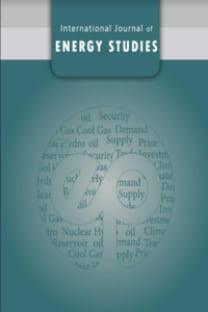The Model of “Free Investment & Centralised Management” in Renewable Energy Production Projects
Renewable energy systems Energy economy, Energy cooperative,
___
- [1] Erbilen, S. Ü., & Şahin, G. (2015). Enerji Coğrafyası Kapsamında Türkiye’de Linyit. Doğu Coğrafya Dergisi, 20(33), 135-160.
- [2] Web: 2017 Doğalgaz Piyasası Sektör Raporu. URL: https://www.epdk.gov.tr/Detay/Icerik/3-0-94/dogal-gazyillik-sektor-raporu, Son Erişim Tarihi: 09.01.2021.
- [3] Rincon, L., Puri, M., Kojakovic, A., & Maltsoglou, I. (2019). The contribution of sustainable bioenergy to renewable electricity generation in Turkey: Evidence based policy from an integrated energy and agriculture approach. Energy Policy, 130, 69-88.
- [4] Bulut, U., & Muratoglu, G. (2018). Renewable energy in Turkey: Great potential, low but increasing utilization, and an empirical analysis on renewable energy-growth nexus. Energy Policy, 123, 240-250.
- [5] Alper, F. Ö. (2018). Yenilenebilir enerji ve ekonomik büyüme arasındaki ilişki: 1990-2017 Türkiye örneği. Çankırı Karatekin Üniversitesi İktisadi ve İdari Bilimler Fakültesi Dergisi, 8(2), 223-242.
- [6] Web: Enerji Kaynaklarına Göre Elektrik Enerjisi Üretimi ve Payları Raporu. URL: https://data.tuik.gov.tr/Kategori/GetKategori?p=cevre-ve-enerji-103&dil=1, Latest Access: 09.01.2021.
- [7] Web: Elektrik Santrallerinin Toplam Kurulu Gücü, Brüt Üretimi, Net Elektrik Tüketimi Raporu. URL: https://data.tuik.gov.tr/Kategori/GetKategori?p=cevre-ve-enerji-103&dil=1, Latest Access: 09.01.2021.
- [8] Abbott, M., & Cohen, B. (2019). Maintaining the security of supply in the Australian national electricity Market with higher levels of renewable energy. The Electricity Journal, 32(9), 106645.
- [9] Gözen, M. (2014). Renewable energy support mechanism in Turkey: Financial analysis and recommendations to policymakers. International Journal of Energy Economics and Policy, 4(2), 274-287.
- [10] Dincer, F. (2011). Overview of the photovoltaic technology status and perspective in Turkey. Renewable and Sustainable Energy Reviews, 15(8), 3768-3779.
- [11] Web: Renewable Energy, Germany Federal Ministry for Economic Affairs and Energy. URL: https://www.bmwi.de/Redaktion/EN/Dossier/renewable-energy.html, Latest Access: 10.01.2021.
- [12] Web: Eylül 2020 Kurulu Güç Raporu. URL: https://www.teias.gov.tr/tr-TR/kurulu-guc-raporlari, Latest Access: 10.01.2021.
- [13] Web: Germany Deutscher Wetterdienst, Global Radiation in Germany. URL: https://www.dwd.de/EN/ourservices/solarenergy/maps_globalradiation_average.html?nn=495490, Latest Access: 10.01.2021.
- [14] Web: Güneş Enerjisi Potansiyel Atlası. URL: https://gepa.enerji.gov.tr/MyCalculator/, Latest Access: 10.01.2021.
- [15] Alcan, Y., Demir, M., & Duman, S. (2018). Sinop İlinin Güneş Enerjisinden Elektrik Üretim Potansiyelinin Ülkemiz ve Almanya ile Karşılaştırarak İncelenmesi. El-Cezeri Journal of Science and Engineering, 5(1), 35-44.
- [16] Web: Rüzgar Enerjisi Potansiyel Atlası. URL: https://repa.enerji.gov.tr/REPA/, Latest Access: 10.01.2021.
- [17] Web: Ocak 2020 Türkiye Rüzgar Enerjisi İstatistik Raporu. URL: https://tureb.com.tr//yayinlar/turkiye-ruzgar-enerjisi-istatistik-raporlari/5, Latest Access: 10.01.2021.
- [18] Web: Biyokütle Enerjisi Potansiyel Atlası. URL: https://bepa.enerji.gov.tr/, Latest Access: 10.01.2021.
- [19] Web: 1 MW Güneş Enerji Santrali GES Kurulum Maliyeti Aylık Yıllık Getiri. URL: https://www.powerenerji.com/1-mw-gunes-enerji-santrali-ges-kurulu-maliyeti-aylik-yillik-geliri.html#1_Mw_Guumlne351_Enerji_Santrali_Amortisman_Suumlresi_Vergi_Kanunlar305, Latest Access: 10.01.2021.
- [20] Web: Lisanssız Enerji Üretimi ve 1MW Lisanssız GES Elektrik Üretim Tesisi Maliyet Cetveli. URL: https://www.enerjiportali.com/lisanssiz-enerji-uretimi-1mw-lisanssiz-ges-elektrik-uretim-tesisi-maliyet-cetveli/, Latest Access: 10.01.2021.
- [21] Web: Güncel GES Maliyetleri ve Yeni Yönetmeliğin Etkileri. (2021, 10 Ocak). Enerji Portalı. URL: https://www.enerjiportali.com/guncel-ges-maliyetleri-ve-yeni-yonetmeligin-etkileri/, Latest Access: 10.01.2021.
- [22] Web: Yenilenebilir Enerji Kaynaklarının Elektrik Enerjisi Üretimi Amaçlı Kullanımına İlişkin Kanun. URL: https://www.resmigazete.gov.tr/eskiler/2005/05/20050518-1.htm, Latest Access: 25.01.2021
- [23] Tagliapietra, S., Zachmann, G., & Fredriksson, G. (2019). Estimating the cost of capital for wind energy investments in Turkey. Energy Policy, 131, 295-301..
- [24] Ertuğrul, Ö. F., & Kurt, M. B. (2009). Yenilenebilir Enerji Kaynaklari Maliyet Analizi ve Sürdürülebilir YEK Uygulamaları. V. Yenilenebilir Enerji Kaynaklari Sempozyumu Bildiriler Kitabı. Haziran, 37-42.
- [25] Dikmen, A. Ç. (2019). Türkiye’de Güneş ve Rüzgar Enerjisinden Elektrik Üretiminin Sera Gazı Emisyonları ve Çevre Maliyetinin Azalmasına Katkıları. Electronic Turkish Studies, 14(2).
- [26] Web: Yastık altı altınlar bankada değerlenecek, hem ülke hem vatandaş kazanacak. URL: https://www.hurriyet.com.tr/ekonomi/yastik-alti-altinlar-bankada-degerlenecek-hem-ulke-hem-vatandas-kazanacak-41612821, Latest Access: 09.01.2021.
- Yayın Aralığı: Yılda 4 Sayı
- Başlangıç: 2016
- Yayıncı: Türkiye Enerji Stratejileri ve Politikaları Araştırma Merkezi (TESPAM)
The Model of “Free Investment & Centralised Management” in Renewable Energy Production Projects
Selman DEMİRKESEN, Halil VARİYENLİ
Abdullah DAĞDEVİREN, Bahadir ACAR, Murat AYDIN
Selman DEMİRKESEN, Halil VARİYENLİ
Bahadir ACAR, Abdullah DAĞDEVİREN, Ahmed JANAANİ, Khandan ROSHANAEI, Edip TAŞKESEN, Göknur KAYATAŞ ONGUN, Mehmet ÖZKAYMAK
